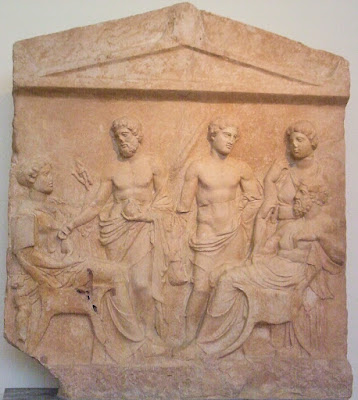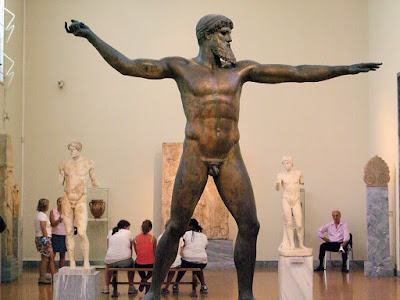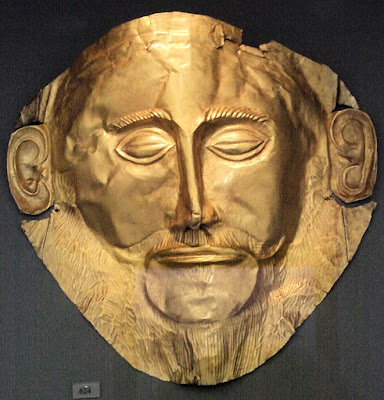 You may have noticed already, but one of my favorite modes of ancient art is the relief frieze. This is an excellent example of one, and yet they still lose their extremities...fingertips, nipples, noses, and penises seem to suffer the most from those tumbles to the ground, and from being battered by other marbles. Click to enlarge.On our last day in Athens (July 17th),
You may have noticed already, but one of my favorite modes of ancient art is the relief frieze. This is an excellent example of one, and yet they still lose their extremities...fingertips, nipples, noses, and penises seem to suffer the most from those tumbles to the ground, and from being battered by other marbles. Click to enlarge.On our last day in Athens (July 17th), we went, via bus, to the National Archaeological Museum. This massive and comprehensive museum would take three days to go through wth any real scrutiny. We did it in a few hours, by focusing on the artifacts and antiquities we were really interested in, and especially those from the many ruins and excavations we had visited the previous month in both Asia Minor and in Greece.
The best part of the museum, by far, is the massive collection of statuary from Cycladic and earlier periods, up to a huge collection of Roman and Greek sculpture. You see a lot of the statuary you've seen in books, in art history class, and on book covers (of Penguin books and literary anthologies). After three hours, you are completely weary and there are still whole collections and periods of antiquity you've missed. I am posting photos of some of my favorites...but hundreds of my favorites aren't here. You'll just have to go to the museum if you get the chance. If you ever do get to Athens (and I highly recommend it), and you only have a day, split it between the Acropolis and the Museum.
Before I go onto the handful of photos, I wanted to say one thing about Athens. When I was there 25 years ago, it was a congested, hot, smelly, polluted town. Over the years, and especially before the Olympics, they have fixed a lot of that. The pollution was not all that much more than any city. They have implemented restrictions on cars, and they have created many pedestrian streets with no cars at all. And on top of that, for the first time in a month, we could actually drink tapwater! And it was great. It was such a great surprise to see the progress Athens had made. When Keelin originally scheduled us for three days there, I was very skeptical. As it turns out, I could have stayed there a week. The subways and buses are good, and if you stay in the Plaka, you can walk almost anywhere you need to go. Highly recommended!
 Cycladic statuary (from the Cycladic Islands, like a couple we visited, Santorini and Rhodes). One of my favorite schools of sculpture. I love the abstracted, gestural figuration. Click to enlarge.
Cycladic statuary (from the Cycladic Islands, like a couple we visited, Santorini and Rhodes). One of my favorite schools of sculpture. I love the abstracted, gestural figuration. Click to enlarge. A bronze Zeus. You've seen this one on the cover of Penguin Books and literary anthologies. Click to enlarge.
A bronze Zeus. You've seen this one on the cover of Penguin Books and literary anthologies. Click to enlarge. Jack Brummet on the rooftop of our hotel, with a close view of the Acroplis' less-flashy backside
Jack Brummet on the rooftop of our hotel, with a close view of the Acroplis' less-flashy backside.
 A bust of Caligula (or head from a statue), from the 1st Century. Click to enlarge. This is one of my favorites, probably because I've read a few books about this mad emperor.
A bust of Caligula (or head from a statue), from the 1st Century. Click to enlarge. This is one of my favorites, probably because I've read a few books about this mad emperor. This is allegedly (although highly unlikely) Agamemnon's pure gold death mask, recovered from Grave Circle V, from the 15th Century BC. Note: the two holes were used with string to hold the mask to the deceased's face. Click to enlarge.
This is allegedly (although highly unlikely) Agamemnon's pure gold death mask, recovered from Grave Circle V, from the 15th Century BC. Note: the two holes were used with string to hold the mask to the deceased's face. Click to enlarge.
 I loved this fantastically sculpted bronze of a horse and jockey recovered from a shipwreck. This was sculpted sometime in the second century BC. Click to enlarge.I'll post some more favorites
I loved this fantastically sculpted bronze of a horse and jockey recovered from a shipwreck. This was sculpted sometime in the second century BC. Click to enlarge.I'll post some more favorites when I get out photos sorted out... /jack, in Seattle
---o0o---





















